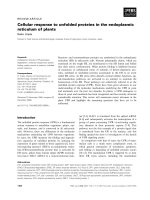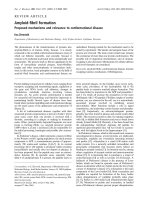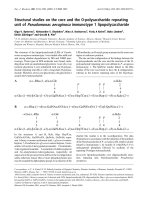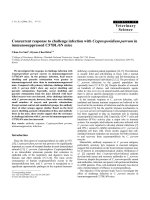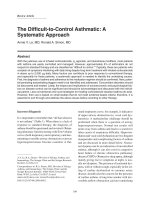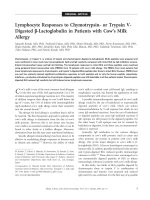Báo cáo y học: "Vaccination response to tetanus toxoid and 23-valent pneumococcal vaccines following administration of a single dose of abatacept: a randomized, open-label, parallel group study in healthy subjects" pot
Bạn đang xem bản rút gọn của tài liệu. Xem và tải ngay bản đầy đủ của tài liệu tại đây (533.64 KB, 11 trang )
Open Access
Available online />Page 1 of 11
(page number not for citation purposes)
Vol 9 No 2
Research article
Vaccination response to tetanus toxoid and 23-valent
pneumococcal vaccines following administration of a single dose
of abatacept: a randomized, open-label, parallel group study in
healthy subjects
Lee Tay
1
, Francisco Leon
2
, George Vratsanos
3
, Ralph Raymond
4
and Michael Corbo
3
1
Clinical Discovery, Bristol-Myers Squibb, PO Box 4000, Princeton, NJ 08543-4000, USA
2
Clinical Development, Inflammatory Diseases, MedImmune, 1 MedImmune Way, Gaithersburg, MD 20878, USA
3
Global Clinical Research, Immunology, PO Box 4000, Bristol-Myers Squibb, Princeton, NJ 08543-4000, USA
4
Global Biometric Sciences, PO Box 4000, Bristol-Myers Squibb, Princeton, NJ 08543-4000, USA
Corresponding author: Lee Tay,
Received: 31 Jul 2006 Revisions requested: 31 Aug 2006 Revisions received: 26 Mar 2007 Accepted: 10 Apr 2007 Published: 10 Apr 2007
Arthritis Research & Therapy 2007, 9:R38 (doi:10.1186/ar2174)
This article is online at: />© 2007 Tay et al., licensee BioMed Central Ltd.
This is an open access article distributed under the terms of the Creative Commons Attribution License ( />),
which permits unrestricted use, distribution, and reproduction in any medium, provided the original work is properly cited.
Abstract
The effect of abatacept, a selective T-cell co-stimulation
modulator, on vaccination has not been previously investigated.
In this open-label, single-dose, randomized, parallel-group,
controlled study, the effect of a single 750 mg infusion of
abatacept on the antibody response to the intramuscular
tetanus toxoid vaccine (primarily a memory response to a T-cell-
dependent peptide antigen) and the intramuscular 23-valent
pneumococcal vaccine (a less T-cell-dependent response to a
polysaccharide antigen) was measured in 80 normal healthy
volunteers. Subjects were uniformly randomized to receive one
of four treatments: Group A (control group), subjects received
vaccines on day 1 only; Group B, subjects received vaccines 2
weeks before abatacept; Group C, subjects received vaccines
2 weeks after abatacept; and Group D, subjects received
vaccines 8 weeks after abatacept. Anti-tetanus and anti-
pneumococcal (Danish serotypes 2, 6B, 8, 9V, 14, 19F and
23F) antibody titers were measured 14 and 28 days after
vaccination. While there were no statistically significant
differences between the dosing groups, geometric mean titers
following tetanus or pneumococcal vaccination were generally
lower in subjects who were vaccinated 2 weeks after receiving
abatacept, compared with control subjects. A positive response
(defined as a twofold increase in antibody titer from baseline) to
tetanus vaccination at 28 days was seen, however, in ≥ 60% of
subjects across all treatment groups versus 75% of control
subjects. Similarly, over 70% of abatacept-treated subjects
versus all control subjects (100%) responded to at least three
pneumococcal serotypes, and approximately 25–30% of
abatacept-treated subjects versus 45% of control subjects
responded to at least six serotypes.
Introduction
Treatment with abatacept has demonstrated efficacy in
patients with active rheumatoid arthritis (RA) and an inade-
quate response to methotrexate, and in those with an inade-
quate response to anti-TNF therapy [1-3]. Abatacept is a
soluble fusion protein consisting of the extracellular domain of
human cytotoxic T-lymphocyte-associated antigen-4 linked to
the Fc (hinge, CH2 and CH3 domains) portion of human IgG
1
,
which has been modified to be noncomplement fixing. Abata-
cept is the first in a class of agents for the treatment of RA that
selectively modulates the CD80/CD86:CD28 co-stimulatory
signal required for full T-cell activation [4]. Activation of T cells
usually requires two signals from antigen-presenting cells
[5,6]. The first signal is mediated through the T-cell receptor
via an interaction with major histocompatibility complex-pre-
sented peptide antigen [6]. The second, or co-stimulatory, sig-
nal is delivered following the engagement of CD80/CD86 on
antigen-presenting cells with a cognate receptor, CD28, on
the surface of the T cell [6,7]. Abatacept, a selective co-stim-
ulation modulator, inhibits CD28-dependent T-cell activation
by binding to CD80 and CD86 [4].
AE = adverse events; ELISA = enzyme-linked immunosorbent assay; i.m. = intramuscular; i.v. = intravenous; RA = rheumatoid arthritis; TNF = tumor
necrosis factor.
Arthritis Research & Therapy Vol 9 No 2 Tay et al.
Page 2 of 11
(page number not for citation purposes)
The impact of abatacept on humoral responses to two T-cell-
dependent neoantigens, bacteriophage X174 and keyhole lim-
pet hemocyanin, was previously evaluated in psoriasis patients
treated with abatacept [8]. While the responses to these
neoantigens were reduced, the primary response to these T-
cell-dependent antigens was not completely blocked. In addi-
tion, tertiary and quaternary responses were restored following
discontinuation of abatacept administration, demonstrating
that tolerance to these neoantigens was not induced [8].
In the present article we describe the effect of a single dose of
abatacept on the humoral response in healthy subjects to two
vaccines, tetanus toxoid vaccine and 23-valent pneumococcal
vaccine. This study was carried out in normal healthy subjects
in order to evaluate the effects of abatacept on the response
to therapeutic vaccines in intact immune systems before eval-
uating the response in RA patients. Patients with active RA
may not have normal immune function parameters, and often
receive background disease-modifying antirheumatic drugs,
many of which are immunosuppressive. It was intended that
data from this study would guide the design of other studies
evaluating vaccine responses in patients with RA. These criti-
cal studies in 'real-world' RA patients are ongoing. In addition,
the effect of abatacept upon two different types of antigen
response was evaluated. The tetanus toxoid vaccine com-
prises a peptide antigen, and, since most individuals in the
United States have been vaccinated with tetanus toxoid, the
response measured in this study can be considered a T-cell-
dependent memory response. Polysaccharides, however, are
able to elicit responses in the absence of T-cell help, although
the magnitude of the response is reduced under those circum-
stances [9-11]. The response to pneumococcal vaccine
measured in the present study is therefore not entirely T-cell
independent, or the response is less T-cell dependent. Finally,
as a normal humoral response to T-cell-dependent antigens
peaks at around 2 weeks [12], we also analyzed the impact on
humoral response of the timing of vaccination relative to abata-
cept administration.
Materials and methods
Study design
This open-label, parallel-group, controlled study was con-
ducted at three study centers in the United States. Subjects
were randomized to one of four treatment groups (Figure 1).
Group A (control group) subjects received separate 0.5 ml
intramuscular (i.m.) injections of tetanus toxoid and 23-valent
pneumococcal vaccines on day 1 without abatacept.
Group B subjects (vaccines 2 weeks before abatacept)
received separate 0.5 ml i.m. injections of tetanus toxoid and
23-valent pneumococcal vaccines on day 1, followed 14 days
later by a single intravenous (i.v.) dose of 750 mg abatacept.
Serum samples were collected prior to the abatacept infusion
on study day 14 and 14 days later on study day 28.
Group C subjects (vaccines 2 weeks after abatacept)
received a single i.v. dose of 750 mg abatacept on day 1, fol-
lowed 14 days later by separate 0.5 ml i.m. injections of teta-
nus toxoid and 23-valent pneumococcal vaccines. Serum
samples were obtained on study day 14 prior to vaccinations
and at 14 and 28 days after the vaccinations (study days 28
and 42, respectively).
Figure 1
Patient disposition from enrollment to completion of the trialPatient disposition from enrollment to completion of the trial. *Abatacept administered after immunoglobulin (Ig) determination at day 14.
Available online />Page 3 of 11
(page number not for citation purposes)
Group D subjects (vaccines 8 weeks after abatacept)
received a single i.v. dose of 750 mg abatacept on day 1,
followed 56 days later by separate 0.5 ml i.m. injections of tet-
anus toxoid and 23-valent pneumococcal vaccines.
Serum samples were obtained for subjects of Groups A and
B at study days 14 and 28, for Group C subjects at study days
28 and 42, and for Group D subjects at study days 70 and 84.
Healthy male or female subjects (aged 18–65 years inclusive)
with a body weight ≥ 60 kg and ≤ 100 kg were enrolled. Sub-
jects were excluded if they had received any live vaccine within
the prior 4 weeks, had received a tetanus booster or pneumo-
coccal vaccine within 5 years or if they had baseline anti-teta-
nus antibodies below clinically detectable levels. Anti-tetanus
and anti-pneumococcal (Danish serotypes 2, 6B, 8, 9V, 14,
19F and 23F) antibody titers were measured by ELISA at 14
and 28 days after vaccination by a central laboratory. Abata-
cept serum concentrations were measured at the same time
as the antibody titers were determined.
This study was carried out in accordance with the ethical prin-
ciples of the Declaration of Helsinki and was approved by Insti-
tutional Review Boards. All subjects gave informed consent.
Drug administration and vaccination
Abatacept 750 mg was administered over 30 minutes by i.v.
infusion using a calibrated, constant-rate infusion. Tetanus tox-
oid vaccine (Aventis Pasteur Inc., Swiftwater, PA, USA) and
23-valent pneumococcal vaccines (Merck & Co Inc., White-
house Station, NJ, USA) were administered separately via i.m.
injection in either the deltoid or the lateral mid-thigh.
Abatacept and antibody assays
Serum samples were used to determine antibody levels. The
assay to quantify IgG anti-tetanus toxoid antibody levels was
based on a previously described methodology [13]. The assay
to quantify IgG anti-pneumococcal antibody levels was based
on the Procedures of the World Health Organization Pneumo-
coccal Serology Reference Laboratories at the Institute of
Child Health, University College, London, UK, and on the pro-
cedures of the Department of Pathology, University of Ala-
bama at Birmingham, AL, USA [14]. All analyses were carried
out at the Center for Vaccine Research and Development, St
Louis University Health Sciences Center, St Louis, MO, USA.
The antibody response against tetanus toxoid vaccine was
expressed as absolute titers of antibodies. Serum samples for
the quantification of abatacept were collected at baseline,
prior to vaccinations, and at the time when the samples were
collected for antibody determinations [15].
Safety assessments
Subjects were monitored for adverse events (AE), serious AE
and vital signs prior to dosing with abatacept and upon
discontinuation.
Statistical methods
All subjects in all four groups were included in the safety anal-
ysis. Geometric means and the percentage of the coefficient
of variation were reported for antibody concentrations. For
each antibody, point estimates and 95% confidence intervals
were constructed for the geometric mean changes from pre-
vaccination to postvaccination antibody levels. These con-
structions were from the results of repeated-measures
analyses of covariance on the natural logarithm of the antibody
levels, with the treatment group and the study day as factors
and the log of the baseline (prevaccination) antibody level as
the covariate. For each antibody, point estimates and 95%
confidence intervals for the prevaccination to postvaccination
changes on the log scale were exponentiated to obtain esti-
mates for geometric means and ratios of geometric means
(fold increase) on the original scale. A twofold or higher
increase above the baseline levels of specific antibodies was
considered a clinically significant or positive immune response
against tetanus toxoid and to each of the seven chosen sero-
types of the 23-valent pneumococcal vaccine [16,17].
Results
The baseline demographics and clinical characteristics of the
80 subjects enrolled in this study were similar across the four
groups. The mean age of subjects was 34–36 years (Table 1).
Of the 80 subjects, 77 (96%) completed treatment and three
(4%) discontinued early from the study.
Overall, 59 AE were experienced by 29 subjects (49.2%)
treated with abatacept, compared with 25 AE reported in 13
subjects (65.0%) who did not receive abatacept (Group A,
control group). The most frequently reported AE in Group A
subjects were injection-site pain (50.0%), headache (10.0%)
and pharyngolaryngeal pain (10.0%). The most frequently
reported treatment-emergent AE in the abatacept-treated
groups were headache (20.3%), injection-site pain (10.2%)
and viral infection (10.2%).
One subject (1.7%) in Group D experienced a serious adverse
event of generalized urticaria 5 minutes after the end of the
first abatacept infusion, which re-occurred at 90 minutes
postinfusion. The investigator reported the event as moderate
in intensity and probably related to the study drug. The subject
was treated with epinephrine and diphenhydramine, remained
hospitalized overnight for observation and was discharged on
study day 2. The event was completely resolved by study day
3.
Arthritis Research & Therapy Vol 9 No 2 Tay et al.
Page 4 of 11
(page number not for citation purposes)
Abatacept serum concentration levels
The observed abatacept serum concentrations levels were
consistent with the dose of abatacept administered and its rel-
ative timing.
Subjects randomized to Group A (control group, vaccines
only) did not receive abatacept, as reflected in Table 2. Sub-
jects randomized to Group B received vaccines 2 weeks prior
to treatment with abatacept. In this group, serum samples
were collected prior to the abatacept infusion on study day 14
and on study day 28. This is reflected in serum concentrations
below the lower limit of quantification on day 14, and a mean
serum concentration of 28.6 μg/ml on study day 28.
Subjects randomized to Group C received vaccines 2 weeks
after treatment with abatacept. The mean serum concentra-
tions observed for subjects in this group – taken 14 and 28
days after vaccinations of 12.5 μg/ml and 6.1 μg/ml, respec-
tively – are again consistent with values at the corresponding
time points in previous studies in healthy subjects.
Finally, subjects randomized to Group D received vaccines 8
weeks after treatment with abatacept. The observed mean
serum concentrations of 1.3 μg/ml on study day 70 is consist-
ent with concentration levels obtained in previous studies. Fur-
thermore, the mean serum concentration of 0.4 μg/ml on study
day 84 is consistent with concentrations that would be
expected based on a half-life of approximately 14 days for
abatacept.
Antibody responses in the control group
In the control group (Group A), not all normal, healthy subjects
responded fully to the two vaccines at day 14 and 28. For the
tetanus toxoid, approximately 95% and 75% of subjects at
days 14 and 28, respectively, achieved at least a twofold
increase in antibody titers. For the pneumococcal vaccine,
Table 1
Subject demographics
Characteristic Group A (vaccines alone on day
1) (n = 20)
Group B (vaccines 2 weeks
before abatacept) (n = 20)
Group C (vaccines 2 weeks after
abatacept) (n = 20)
Group D (vaccines 8 weeks after
abatacept) (n = 20)
Age (years)
Mean 34 34 34 36
Standard deviation 12 13 11 13
Range 18–55 18–56 19–56 20–56
Gender (n (%))
Male 10 (50) 8 (40) 10 (50) 11 (55)
Female 10 (50) 12 (60) 10 (50) 9 (45)
Race (n (%))
White 15 (75) 12 (60) 14 (70) 11 (55)
Black 5 (25) 8 (40) 6 (30) 8 (40)
Other0001 (5)
Table 2
Abatacept serum concentration levels determined 14 and 28 days after vaccination
Group Baseline (μg/ml) 14 days after vaccination (μg/ml) 28 days after vaccination (μg/ml)
Group A
a
(vaccines alone on day 1) N/A N/A N/A
Group B
b
(vaccines 2 weeks before abatacept) N/A N/A 28.6 (26)
Group C (vaccines 2 weeks after abatacept) N/A 12.5 (19) 6.1 (20)
Group D (vaccines 8 weeks after abatacept) N/A 1.3 (56) 0.4 (106)
Data presented as the geometric means (percentage of the coefficient of variation. N/A: not applicable.
a
Subjects in Group A did not receive
abatacept.
b
Subjects in Group B received abatacept at 14 days (serum concentration taken pre-abatacept dosing).
Available online />Page 5 of 11
(page number not for citation purposes)
approximately 45–95% and 50–95% of subjects at days 14
and 28, respectively, achieved at least a twofold increase in
antibody titer across all seven serotypes.
Antibody response to tetanus toxoid
The antibody responses against tetanus toxoid vaccine,
expressed as absolute titers of antibodies, are summarized in
Table 3. The corresponding abatacept serum concentrations
are presented in Table 2.
The intersubject variability in response to tetanus toxoid was
large, with the percentage of the coefficient of variation rang-
ing between 54% and 112% (Table 3). Based on the geomet-
ric mean of the antibody titers, subjects in Group B (received
vaccines 2 weeks before abatacept) appeared little affected to
not affected, with a lowered response of approximately 6%
when compared with the control group (Group A) at 28 days
after vaccination, a reduction within the variability of the assay
(Table 3). For Group C subjects (received vaccines 2 weeks
after abatacept), there appeared to be a lowered response of
approximately 48% and 39% at 14 and 28 days, respectively,
compared with Group A. Subjects in Group D (received vac-
cines 8 weeks after abatacept) were affected to a lesser
extent, with an observed lowered response of approximately
21% and 16% at 14 and 28 days, respectively, compared with
Group A.
The percentage of subjects who mounted a response that was
at least twofold from baseline is shown in Figure 2 for tetanus
toxoid. Across all treatment groups, at least 60% of subjects
were able to generate at least a twofold increase in antibody
response after 28 days. In the control group (Group A), 75%
of subjects reached this level. The responses observed at 14
and 28 days after vaccination were similar.
Antibody responses to 23-valent pneumococcal vaccine
Seven serotypes of 23-valent pneumococcal vaccine were
chosen as a representative sample of differing immunogenic
strengths of pneumococcal vaccine. Serotype 14 (the most
common), serotype 8, serotype 9V and serotype 2 are the
most immunogenic. Figure 3 illustrates the fold increases for
the seven serotypes at days 14 and 28, respectively, and
Table 4 presents the corresponding geometric mean values of
antibody titers.
As with the response to tetanus toxoid, variable response rates
were obtained in the study subjects across individual sero-
types. The percentages of subjects in all treatment groups
achieving a positive response to the different serotypes at 14
and 28 days after vaccination are illustrated in Figure 4a and
4b, respectively. In general, and as expected, the highest
responses were observed for serotypes 14 and 2. The appar-
ent decrease in vaccination response in subjects who were in
Group B cannot be accurately evaluated because of the
higher baseline values obtained in these subjects, a known
cause of reduced relative responses. This randomization vari-
ability is further illustrated by the fact that responses in Group
B subjects appeared decreased even at day 14, prior to the
administration of abatacept. In subjects of Groups C and D,
however – those who were vaccinated after abatacept – lower
average titers on days 14 and 28 were recorded for all
serotypes, except serotype 23F (Table 4). The decrease in
antibody response in Group C subjects at 14 and 28 days
after vaccination ranged from 22% to 69% and from 24% to
68%, respectively. Similarly, the decrease in antibody
response for subjects in Group D determined at 14 and 28
days after vaccination ranged between 12% and 67% and
between 25% and 64%, respectively. No correlation between
the immunogenicity of the serotype of the pneumococcal vac-
cine and the reduction in response was observed.
Figure 5a,b summarizes the number of serotypes to which
subjects responded with at least a twofold increase over base-
line at 14 and 28 days after vaccination, respectively. More
than 90% of subjects in all treatment groups responded to at
least one serotype, over 70% of subjects responded to at least
three different serotypes, and approximately 25% of subjects
responded to at least six different serotypes by day 14 (Figure
5a) and by day 28 (Figure 5b).
Table 3
Geometric means (percentage of the coefficient of variation) of anti-tetanus toxoid antibody titers taken 14 and 28 days after
tetanus toxoid vaccination
Group n Baseline titers (U/ml) Anti-tetanus antibody titers at 14 days
post-vaccination (U/ml)
Anti-tetanus antibody titers at 28 days
post-vaccination (U/ml)
Group A (vaccines alone on day 1) 20 1.6 (106) 11.4 (88) 9.3 (104)
Group B (vaccines 2 weeks before abatacept) 20 1.9 (76) 10.2 (71) 8.7 (68)
a
Group C (vaccines 2 weeks after abatacept) 19
b
2.3 (76) 5.9 (112) 5.6 (98)
Group D (vaccines 8 weeks after abatacept) 19
c
2.3 (54) 9.0 (79) 7.8 (85)
a
n = 19 as one subject discontinued due to an adverse event (this discontinued patient only had samples collected at baseline and day 14).
b
Subject discontinued prior to vaccine administration on day 14 due to toxicology.
c
Subject discontinued prior to vaccine administration on day 56
due to toxicology.
Arthritis Research & Therapy Vol 9 No 2 Tay et al.
Page 6 of 11
(page number not for citation purposes)
Discussion
The purpose of this study was to investigate the effect of
abatacept on the antibody response in healthy subjects prior
to initiating studies in RA patients. Tetanus toxoid vaccine and
the 23-valent pneumococcal vaccine were used to assess the
impact of abatacept on a memory response to a T-cell-
dependent protein antigen and to a less T-cell-dependent
polysaccharide antigen, respectively. Finally, the correlation of
any effect regarding the timing of abatacept administration rel-
ative to the administration of each vaccine was evaluated.
The geometric mean titers were reduced for both vaccines,
suggesting that abatacept does blunt the immune response to
these vaccines. This effect on the response occurred to differ-
ing extents among the groups. For the tetanus toxoid vaccine,
Group C subjects (vaccines 2 weeks after abatacept)
appeared to be the more affected of the three treatment
groups, compared with Group A subjects (control group).
Subjects in Group D (vaccines 8 weeks after abatacept) were
affected to a lesser extent than those in Group C, and Group
B subjects were the least affected.
For the 23-valent pneumococcal vaccine, there appeared to
be lower titers for all serotypes, except serotype 23F, in sub-
jects of Group C (vaccines 2 weeks after abatacept) and of
Group D (vaccines 8 weeks after abatacept). The apparent
decrease in vaccination response in subjects in Group B can-
not be accurately evaluated because of the higher baseline
values obtained in these subjects.
While abatacept reduced the response (geometric mean tit-
ers) of the two vaccines, it did not significantly inhibit the ability
of healthy subjects to develop at least a twofold response to
either the tetanus toxoid or 23-valent pneumococcal vaccine.
Overall, across all treatment groups, >60% subjects were
able to generate at least a twofold increase in antibody
response to tetanus toxoid after day 28, and over 70% of sub-
jects in all treatment groups responded to at least three sero-
types of the pneumococcal vaccine; in addition, approximately
25% of all treated subjects responded to at least six serotypes
– an expected and normal response in healthy subjects
[18,19].
The role of abatacept in the reduction of the geometric mean
titers is supported by the relationship between serum levels of
abatacept present at the time of vaccination and the degree of
inhibition of the humoral response. The most affected group in
this study was Group C (vaccine 2 weeks after abatacept). In
this group, the highest abatacept levels (and presumably a
higher degree of co-stimulation blockade) were observed at
the time of vaccination. By contrast, the observed mean serum
concentration for Group D subjects (vaccine 8 weeks after
abatacept) was very low at the time of vaccination and was
less affected. Group B subjects (vaccine 2 weeks before
Figure 2
Percentage of subjects achieving at least a twofold increase in tetanus toxoid antibodies from baselinePercentage of subjects achieving at least a twofold increase in tetanus toxoid antibodies from baseline.
Available online />Page 7 of 11
(page number not for citation purposes)
abatacept) appeared to be least affected, at least for the teta-
nus toxoid. This may be due to the fact that a peak antibody
concentration in a normal primary immune response is
achieved at around 2 weeks [12], and in Group B subjects
there was presumably a pool of B cells that had completed
their differentiation into antibody-secreting plasma cells before
abatacept was administered.
Abatacept prevents the activation of naive T cells by inhibiting
the second signal required for their co-stimulation. This signal
is mediated by CD80 and CD86, which is expressed on anti-
gen-presenting cells, and by CD28, which is expressed on T
cells. Abatacept may also reduce the activation of memory T
cells (although to a lesser extent than for naïve T cells) [20].
This is consistent with a reduced response against tetanus
toxoid. The inhibition of the CD80/CD86:CD28 co-stimulatory
signal may also potentially prevent the T-cell 'help' needed for
optimal differentiation of CD80/CD86-expressing B cells into
plasma cells, which ultimately secrete antibodies. This inhibi-
tion of B cell–T cell help may be a reason for the reduced
antibody response to thymus-independent polysaccharide
antigens such as those contained in the pneumococcal vac-
cine – responses that cannot be considered completely T-cell
independent since they are enhanced by T-cell help [9,11].
Finally, since abatacept inhibits one of several mediators of co-
stimulation, the partial inhibition observed here is likely to
reflect the redundancy of the co-stimulation mechanism.
This study analyzed the response in healthy volunteers with a
normal immune system to a single dose of abatacept. Future
studies are needed to determine the optimal timing of
Figure 3
Impact of abatacept on antibody titers at 14 and 28 days after vaccination in individual pneumococcal serotypesImpact of abatacept on antibody titers at 14 and 28 days after vaccination in individual pneumococcal serotypes.
Arthritis Research & Therapy Vol 9 No 2 Tay et al.
Page 8 of 11
(page number not for citation purposes)
Table 4
Geometric means (percentage of the coefficient of variation) of antibody titers taken 14 and 28 days after pneumococcal
vaccination
Group n Baseline (μg/ml) 14 days post-vaccination (μg/ml) 28 days post-vaccination (μg/ml)
Serotype 14
Group A 20 1.9 (112) 20.5 (236) 23.5 (199)
Group B 20 1.9 (132) 15.5 (105) 15.4 (111)
a
Group C 19 1.8 (201) 12.0 (195) 12.8 (250)
Group D 19 1.8 (125) 18.0 (155) 12.6 (141)
Serotype 2
Group A 20 1.0 (163) 13.4 (113) 15.4 (110)
Group B 20 1.1 (84) 12.3 (109) 13.2 (107)
a
Group C 19 0.8 (90) 4.1 (118) 4.8 (115)
Group D 19 0.7 (122) 7.0 (132) 7.7 (136)
Serotype 23F
Group A 20 0.9 (101) 3.0 (112) 3.3 (113)
Group B 20 1.8 (124) 5.6 (87) 4.9 (89)
a
Group C 19 1.2 (158) 4.5 (112) 5.1 (106)
Group D 19 1.5 (125) 6.2 (92) 6.7 (90)
Serotype 8
Group A 20 1.5 (120) 10.1 (138) 9.6 (114)
Group B 20 2.3 (104) 12.0 (61) 10.5 (81)
a
Group C 19 1.4 (104) 4.0 (68) 4.4 (64)
Group D 19 1.6 (74) 5.1 (144) 5.2 (106)
Serotype 9V
Group A 20 0.9 (148) 6.1 (102) 6.4 (99)
Group B 20 1.3 (158) 4.0 (97) 3.9 (101)
a
Group C 19 0.9 (190) 3.0 (147) 3.2 (108)
Group D 19 0.9 (119) 2.0 (107) 2.3 (106)
Serotype 19F
Group A 20 5.3 (95) 13.0 (125) 13.9 (150)
Group B 20 10.3 (127) 19.9 (105) 19.6 (97)
a
Group C 19 4.3 (117) 10.0 (178) 10.3 (180)
Group D 19 5.6 (75) 9.9 (89) 10.3 (88)
Serotype 6B
Group A 20 1.6 (103) 5.9 (197) 6.1 (204)
Group B 20 3.1 (126) 7.8 (87) 7.1 (95)
a
Group C 19 1.9 (140) 4.6 (147) 4.6 (141)
Group D 19 1.8 (114) 3.5 (159) 3.5 (151)
a
n = 19.
Available online />Page 9 of 11
(page number not for citation purposes)
Figure 4
Percentage of subjects achieving at least a twofold increase in antibody titers for individual pneumococcal serotypesPercentage of subjects achieving at least a twofold increase in antibody titers for individual pneumococcal serotypes. (a) 14 days after vaccination
and (b) 28 days after vaccination.
Arthritis Research & Therapy Vol 9 No 2 Tay et al.
Page 10 of 11
(page number not for citation purposes)
Figure 5
Number of pneumococcal serotypes to which subjects respondedNumber of pneumococcal serotypes to which subjects responded. (a) 14 days after vaccination and (b) 28 days after vaccination.
Available online />Page 11 of 11
(page number not for citation purposes)
vaccination in RA patients receiving abatacept continuously,
possibly with other concomitant disease-modifying antirheu-
matic drugs such as methotrexate.
Conclusion
This study suggests that abatacept blunts the effectiveness of
the immune response, but does not significantly inhibit the
ability of healthy subjects to develop a clinically significant or
positive immune response (at least a twofold increase above
baseline) to both tetanus toxoid and 23-valent pneumococcal
vaccines.
Competing interests
LT, GV, RR and MC are employees of Bristol-Myers Squibb
(Princeton, NJ, USA) and own stock options. FL is an ex-
employee of Bristol-Myers Squibb (Princeton, NJ, USA) but no
longer possesses stock in Bristol-Myers Squibb or has any
other financial disclosure.
Authors' contributions
LT, FL, GV and MC were involved in the development of the
study design. RR developed the statistical plan and performed
the analyses. LT also participated in the pharmacokinetic anal-
ysis and design. All authors were involved in the drafting and
revision of the manuscript. All authors read and approved the
final manuscript.
Acknowledgements
This study was funded and sponsored by Bristol-Myers Squibb (Prince-
ton, NJ, USA). Clinical trial registration number: NCT00279734. The
authors would like to thank Hannah Hess, who was the clinical scientist
for the study, and Elizabeth Burtally, MSc, Medicus International, for her
editorial assistance. Editorial support was funded by Bristol-Myers
Squibb (Princeton, NJ, USA).
References
1. Kremer JM, Dougados M, Emery P, Durez P, Sibilia J, Shergy W,
Steinfeld S, Tindall E, Becker JC, Li T, et al.: Treatment of rheu-
matoid arthritis with the selective costimulation modulator
abatacept: twelve-month results of a phase iib, double-blind,
randomized, placebo-controlled trial. Arthritis Rheum 2005,
52:2263-2271.
2. Kremer JM, Genant HK, Moreland LW, Russell AS, Emery P, Abud-
Mendoza C, Szechinski J, Li T, Ge Z, Becker JC, Westhovens R:
Effects of abatacept in patients with methotrexate-resistant
active rheumatoid arthritis: a randomized trial. Ann Intern Med
2006, 144:865-876.
3. Genovese M, Becker JC, Schiff M, Luggen M, Sherrer Y, Kremer J,
Birbara C, Box J, Natarajan K, Nuamah I, et al.: Abatacept for
rheumatoid arthritis refractory to tumor necrosis factor
inhibition. N Engl J Med 2005, 353:1114-1123.
4. Linsley PS, Brady W, Urnes M, Grosmaire LS, Damle NK, Ledbet-
ter JA: CTLA-4 is a second receptor for the B cell activation
antigen B7. J Exp Med 1991, 174:561-569.
5. Goldsby R, Kindt T, Osborne B: Immunology 5th edition. New
York: W. H. Freeman and Company; 2003.
6. Yamada A, Salama AD, Sayegh MH: The role of novel T cell cos-
timulatory pathways in autoimmunity and transplantation. J
Am Soc Nephrol 2002, 13:559-575.
7. Bretscher P, Cohn M: A theory of self-nonself discrimination.
Science 1970, 169:1042-1049.
8. Abrams JR, Lebwohl MG, Guzzo CA, Jegasothy BV, Goldfarb MT,
Goffe BS, Menter A, Lowe NJ, Krueger G, Brown MJ, et al.:
CTLA4Ig-mediated blockade of T-cell costimulation in patients
with psoriasis vulgaris. J Clin Invest 1999, 103:1243-1252.
9. Wu ZQ, Khan AQ, Shen Y, Schartman J, Peach R, Lees A, Mond
JJ, Gause WC, Snapper CM: B7 requirements for primary and
secondary protein- and polysaccharide-specific Ig isotype
responses to Streptococcus pneumoniae. J Immunol 2000,
165:6840-6848.
10. Wu ZQ, Shen Y, Khan AQ, Chu CL, Riese R, Chapman HA, Kan-
agawa O, Snapper CM: The mechanism underlying T cell help
for induction of an antigen-specific in vivo humoral immune
response to intact Streptococcus pneumoniae is dependent
on the type of antigen. J Immunol 2002, 168:5551-5557.
11. Jeurissen A, Wuyts G, Kasran A, Ramdien-Murli S, Blanckaert N,
Boon L, Ceuppens JL, Bossuyt X: The human antibody reponse
to pneumococcal capsular polysaccharides is dependent on
the CD40-CD40 ligand interaction. Eur J Immunol 2004,
34:850-858.
12. Janeway C: Immunobiology 6th edition. New York: Garland
Publishing; 2001.
13. Manghi MA, Pasetti MF, Brero ML, Deluchi S, di Paola G, Mathet
V, Eriksson PV: Development of an ELISA for measuring the
activity of tetanus toxoid in vaccines and comparison with the
toxin neutralization test in mice. J Immunol Methods 1994,
168:17-24.
14. Wernette CM, Frasch CE, Madore D, Carlone G, Goldblatt D,
Plikaytis B, Benjamin W, Quataert SA, Hildreth S, Sikkema DJ, et
al.: Enzyme-linked immunosorbent assay for quantitation of
human antibodies to pneumococcal polysaccharides. Clin
Diagn Lab Immunol 2003, 10:514-519.
15. Bristol-Myers Squibb (BMS) Internal Report: Enzyme inmmu-
noassay for the quantitation of fixed process human CTLA4Ig
fusion protein (BMS-188667) in human serum 1995. BMS Doc-
ument Control No 910050896, V30
16. Talesnik E, Vial PA, Labarca J, Mendez C, Soza X: Time course of
antibody response to tetanus toxoid and pneumococcal cap-
sular polysaccharides in patients infected with HIV. J Acquir
Immune Defic Syndr Hum Retrovirol 1998, 19:471-477.
17. Elkayam O, Paran D, Caspri D, Litinsky I, Yaron M, Charboneau D,
Rubins JB: Immunogenicity and safety of pneumococcal vacci-
nation in subjects with rheumatoid arthritis or systemic lupus
erythematosus. Clin Infect Dis 2002, 34:147-153.
18. Go ES, Ballas ZK: Anti-pneumococcal antibody response in
normal subjects: a meta-analysis. J Allergy Clin Immunol 1996,
98:205-215.
19. Musher DM, Groover JE, Rowland JM, Watson DA, Struewing JB,
Baughn RE, Mufson MA: Antibody to capsular polysaccharides
of Streptococcus pneumoniae: prevalence, persistence, and
response to revaccination. Clin Infect Dis 1993, 17:66-73.
20. Ndejembi M, Patke D, Bingaman A: CTLA-4Ig inhibits IL-2 pro-
duction and in vivo expansion of antigen-stimulated memory
CD4 T cells. Clin Immunol 2005, 115:S219-S220.

